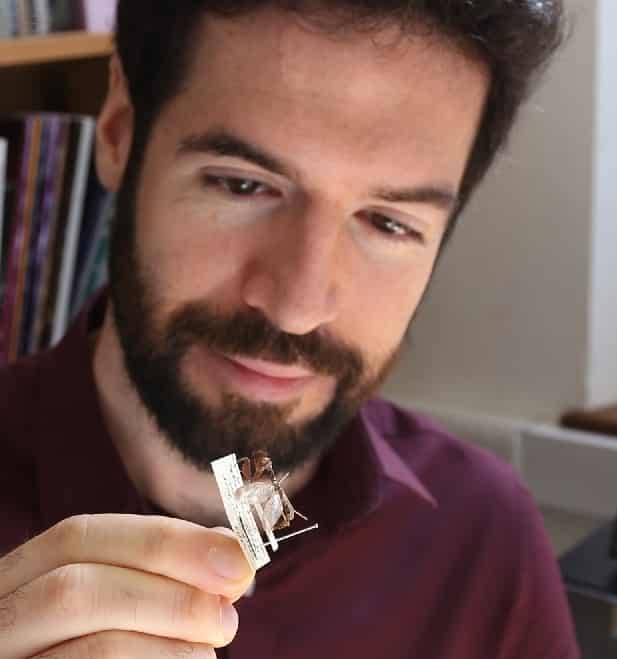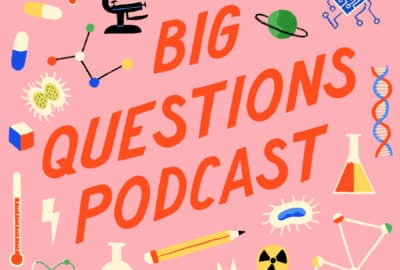Could ‘Jurassic Park’ actually happen?
Wednesday 31st May 2023, 12.30pm
“Life finds a way”…This year marks the thirtieth anniversary of the release of Stephen Spielberg and Universal Studio’s dinosaur masterpiece ‘Jurassic Park’. A rousing soundtrack, gutsy kids, and graphics which have stood the test of time remarkably well – the film has undeniably become a classic. But – here’s the big question – could it actually happen? Using today’s technologies, could we actually extract ancient dinosaur DNA from blood-sucking mosquitoes preserved in amber? And then use that DNA to clone a prehistoric beast? We ask palaeontologist Dr Ricardo Pérez-de la Fuente to help us sort the science fact from the science fiction.
Emily Elias: This year marks 30 years since Steven Spielberg and Universal Pictures originally brought dinosaurs to life on the big screen. And with the advances in modern science, on this episode of the Oxford Sparks Big Questions podcast, we’re asking, could ‘Jurassic Park’ actually happen?
Hello, I’m Emily Elias, and this is the show where we seek out the brightest minds at the University of Oxford, and we ask them the big questions. And for this one, we have found a researcher/‘Jurassic Park’ debunker.
Ricardo Pérez-de la Fuente: My name is Ricardo Pérez-de la Fuente, and I am a palaeontologist, working at Oxford University Museum of Natural History. My research aims to understand how terrestrial ecosystems worked in deep time, by looking at fossil insects, and other arthropods, such as spiders or ticks. I specialise in the study of amber, and the fossils that it contains.
Emily: Okay. So, instantly, I’m getting flashbacks to ‘Jurassic Park’.
(Film clip plays)
“There it is. Welcome to Jurassic Park. We have made living biological attractions so astounding that they’ll capture the imagination of the entire planet.”
Spoiler alert, for people who haven’t seen the film, one of the key plot points in it is that bugs are trapped in amber, and they extract that DNA to make dinosaurs. So does that whole thing with amber work? Is it a good preserver of bugs?
Ricardo: Yeah. Absolutely. Amber, a fossilised plant resin, is an incredible organic material. Amber preserves morphology, and the anatomy of organisms, with unmatched detail. Other materials, such as ice or tar, do as well, but never for millions of years into the past. With amber, we can essentially study organisms that were alive more than 100 million years ago, and look at the same features that we see when examining a living relative.
Essentially, each amber piece is like a little window into the past. Since resin was able to capture small bits of the ecosystem from millions of years ago, and transport them through time until today, that means that amber also captures interactions between organisms, such as parasites feeding on their hosts, or two individuals from the same species mating, and this is something extremely unlikely to find preserved in the fossil record otherwise.
Emily: So this amber literally froze everything inside it, and it’s a snapshot into the past.
Ricardo: Exactly. Yeah, yeah. In a way, it’s almost like a photograph of this moment in time that froze. Right? And, of course, that’s amazing, and that’s an ability that we can use, in order to understand how ecosystems worked in the past, and how organisms interacted.
We need to think about the fact, for instance, that when a dinosaur is discovered nowadays, normally it is a dinosaur, or any other organism, that is preserved in rocks, which is the common preservation that you get in the fossil record.
The moment between the death of that organism, or the production of a remain from that organism, let’s say a leaf detaching from the tree, that time, the moment between the death, and the moment in which that remain falls to the ground and starts potentially the process of fossilisation, we can have days, or even weeks passing by, and during that time we are losing a lot of information from the organic remains.
In amber, that’s not the case. In resin, resin captured organisms almost instantly, and that’s the amazing thing about it.
Emily: I mean, this almost sounds too good to be true. Is there a downside of amber?
Ricardo: Indeed, that’s true, yeah. Well, not everything is good news with amber. Even if amber has endured millions of years underground, waiting to be discovered, once unearthed, amber decays very fast, and this is due to being exposed to UV light, oxygen, and the changes in temperature and humidity.
So all these factors start cracking the amber, first at the surface level, but then the cracks can start to penetrate into the amber. So storing amber also in museums’ collections is actually incredibly challenging, even when controlling the environmental conditions near to perfection.
Emily: So it’s super strong, and yet super delicate. How do you actually go about studying it, and making sure it doesn’t disintegrate as you’re looking at it?
Ricardo: Before we actually manage to study any amber piece, normally we encase it in artificial resin. So we make these preparations made of, let’s say, artificial amber, so to speak, or something that is close to being amber, in some properties, and thanks to that, we can increase the stability of an amber piece.
And also, sometimes, actually, because we use sometimes vacuum chambers, we can get artificial resin to penetrate into the cracks that otherwise would be creating this mirror effect into our sample, and would prevent us from looking into the fossilised insects preserved inside.
So yeah, so before, actually, we study any amber piece, we tend to prepare those amber pieces, so that we can start studying them.
Emily: And so once your samples are prepared, what kind of technology do you use to look at them?
Ricardo: Still to this day, in palaeoentomology, or the study of fossil insects, we use technology that was created more than 200 years ago. Our base equipment is just a microscope, obviously better if it’s a good one, right, equipped with what we call a camera lucida.
A camera lucida is essentially this device consisting of a mirror that reflects anything that we put on the table; a sheet of paper, most usually. Right? And so, through one ocular of the microscope, we see the sample, and through the other ocular, we can see the sheet of paper, and the tip of our pencil.
Then our lovely brain is able to merge both images, and then we can trace the fossil on the paper, without stop looking through the microscope. I think it’s genius, and it’s been around for such a long time. Right?
Aside from those classic techniques, nowadays we can also use cutting-edge technology, such as microtomography, using x-rays, sometimes working in high-tech facilities, such as particle accelerators.
Using this technique, we can do all sorts of cool stuff with amber and its fossils, such as virtually extracting the fossils from the amber, to get to look at them from every possible angle, and even make virtual cuts of the fossils, to see what’s inside.
And it’s interesting, because thanks to these microtomographic techniques, we know that amber has the potential to preserve soft tissue, such as muscle, or nervous system, and colleagues have actually been able to even compare the brain of 100-million-year-old ants with those of modern relatives.
Emily: That’s wild. Okay. So getting back to ‘Jurassic Park’, a huge part of the movie was they were able to extract the DNA from mosquitoes that were trapped in the amber. Can you get to a point where you can actually extract DNA from amber, like in the movie?
Ricardo: Okay, that’s a key point. Right? Well, the interesting part is that, it turns out that ‘Jurassic Park’ was backed up by real science.
‘Jurassic Park’, the novel, was out in 1990. Okay? Two years later, a team of scientists published papers in which they claimed to have extracted DNA from bees and termites preserved in Dominican amber, about 20 million years old.
The first ‘Jurassic Park’ movie came out in June 1993 in the United States, and at basically the same time, another paper came out claiming to have extracted DNA from 130-million-year-old beetles preserved in Lebanese amber. This is Cretaceous, which is the period after the Jurassic, from the Mesozoic. Now, all this creates a very interesting environment, in which… it was probably one of these instances where science and science fiction inspired each other.
And the interesting part, though, is that after those initial experiments, multiple teams tried to replicate those processes of DNA extraction from amber, but to no avail, and therefore they concluded that the analysed amber samples must have been contaminated with modern DNA in the original experiments.
This is interesting to note, that DNA loses its integrity and its structure relatively easily. In amber, tissues become mummified, dehydrated, and that is really bad for the preservation of DNA.
At the same time, though, it’s really, really difficult to fully get rid of DNA fragments in the environment, and so it’s really difficult to avoid DNA contamination, and 30 years ago, even more so.
Emily: So is the theory, then, that the DNA that they were able to extract from these bees, and these beetles, was actually possibly a contamination, and not the DNA from those creatures?
Ricardo: Yes, that’s exactly what the scientific community concluded. Right? Since those papers were only singular examples of that extraction, and afterwards, all those repeated efforts, it has not been possible to extract DNA after those initial experiments, more than 25, almost 30 years ago.
Emily: Okay, but we’re in the age of the iPhone now. Like, technology has come a long way since the original ‘Jurassic Park’ came out. Do you think it’s possible that we could extract DNA?
Ricardo: Well, that’s true. Right? And the gap between science and science fiction keeps narrowing, and, of course, palaeontology is not an exception. In our field, we constantly get surprised about the kind of things that fossil record has managed to preserve for even hundreds of millions of years. Right?
But, to this day, it has not been possible to extract ancient DNA from amber fossils, despite repeated attempts, with increasingly sophisticated technology. The closest we’ve been to that is actually extracting and sequencing DNA from resin that is just a few years to decades old, but even in those cases, our colleagues saw that DNA is already highly degraded.
And this is interesting. Right? Even if we were able to extract DNA from, say, a mosquito trapped in amber, that could have bitten a T. rex, then we would need to face a second major problem, if we wanted to make our little ‘Jurassic Park’ experiment, and that would be cloning.
Emily: Yes. Cloning. That is another key point of the movie. It was not just that they were able to get the DNA out; they were then able to clone the dinosaurs, to make it. How would that work?
Ricardo: As currently understood, cloning entails taking DNA from a donor cell, and putting it inside the nucleus of an egg cell from a host, the DNA of which has been previously removed. Now, that egg cell is necessary, because it has the biological equipment required to trigger the developmental pattern for an embryo to form.
Now, the chances for cloning to succeed are extremely low, even in living species, due to multiple chained steps involved in the process, all of which are poorly efficient. So to clone a Jurassic dinosaur, based on ancient DNA, if we were ever able to obtain it, we would necessarily need an active, living egg cell, from the closest modern relative, which would have to be a modern bird.
Of course, the problem is that the substantial evolutionary distance between the two species, the extinct one and the living one, would almost certainly entail multiple biological incompatibilities between the donor DNA and the host egg cell, on top of all the challenges of cloning as a technique itself.
All that would almost certainly prevent that embryo, which would be kind of like a hybrid, to develop properly, or at all, and eventually survive as a fully-grown organism. So yeah, definitely a major issue here with cloning.
Emily: So we’re not even close to that yet. (Laughter) Does that mean I should not be afraid that, all of a sudden, a theme park filled with dinosaurs is going to emerge, and I will be running for my life?
Ricardo: Not in the near future, in a park full of T. rex, Triceratops, and Velociraptors, though. But the interesting part here is that we can still create a theme park full of dinosaurs today; you just need to populate it with birds. Because birds are dinosaurs. Dinosaurs still walk, and fly, amongst us. Not all the dinosaurs went extinct 66 million years ago.
Avian dinosaurs, this term of ‘avian’ relates to Aves, or related to birds, these are birds in a wide sense, avian dinosaurs, and possessing flapping flight, already existed in the late Jurassic, about 150 million years ago. Now, relatives of these early birds survived the mass extinction event, and gave origin to the lineage of modern birds.
So something that I enjoy saying to people is that, next time you hear that dinosaurs went extinct, tell these people to go stare at a pigeon up close, and look for the inner T. rex within them. That’s something that I recommend everyone to do.
Emily: That’s going to be a hard sell to a three-year-old. (Laughter)
Ricardo: (Laughter)
Emily: This podcast was brought to you by Oxford Sparks, from the University of Oxford, with music by John Lyons, and a special thank you to Ricardo Pérez-de la Fuente.
If you’ve got a big question, get in touch. We are on social media @OxfordSparks, plus there is a website, oxfordsparks.ox.ac.uk.
I’m Emily Elias. Bye for now.
Transcribed by UK Transcription.




